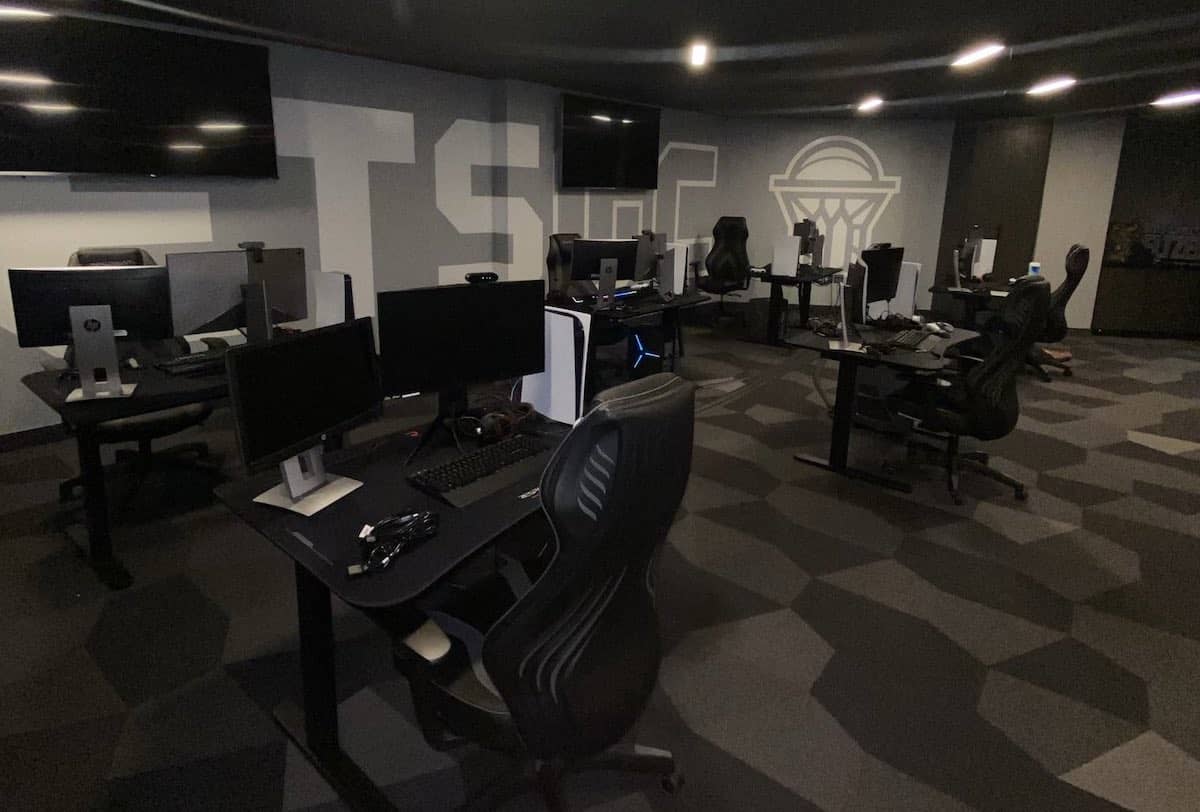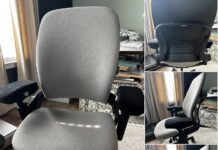A decently working office chair with tattered upholstery can still serve you. Most people send them to the garbage bin right away. Who would want to sit on a torn fabric chair with the insides hanging out? Of course, no one would. But if the chair still works fine, you should consider changing the upholstery instead.
Reupholstering your office chair can also save you moolah, especially if you did spend quite a sum on the chair in the beginning. And it could also be fun! Think of the array of fabric options you have!
So we are going to help you spruce up your tattered office chair. And if you’re into crafts and DIYs, you’d find this rather entertaining too.

Standingdesktopper's pick
How to Spruce up a tattered office chair
It’s very common to reupholster a dining chair or a couch, but an office chair? Yes, you heard it right. It might be uncharted territory but it can be done. Keep scrolling to find out how you can outfit a new fabric on your cushioned office chair.
Prepare the materials and tools
We will be needing the following:
- Sewing needle, thread, and cord
- Scissors
- Steam iron
- Needle nose pliers
- Staple puller
- Pin nailer with 1-inch pins
- Serger
- Seam ripper
- Sewing machine
- Air Gun with staples
And since we are going to work with staple guns, don’t forget to wear goggles or any eye protection. Make sure you’re wearing your protective gloves too.
Cut it off in parts
It might be possible to complete this entire project in a day. But if you are new to DIYs, you might find it overwhelming. Thus, we advise cutting the project into three sessions- the panel, backrest, and the seat.
You can do one part per day. Others might find it more feasible to do one part every weekend if they are working on the weekdays. It’s also wise to do it per part since you have to dismantle the parts, sew the new fabric, and reassemble them again. So this method will ensure that you have enough energy and gusto for each part.
The seat part
The first step is removing the seat. We opt to start on the seat first. But feel free to start on the panel or the backrest if that’s what you prefer.
- Turn the chair on one side and check how the seat is connected to the chair. You’ll be seeing several screws, a lever, and it can be confusing at first. Check for how many screws attach the seat to the other parts of the chair and the armrest, and start to loosen them.
- Pull the seat out and place it on your working table. Make sure to set aside all the screws so that you will not lose them. We still have to reassemble everything after.
- If you check on the fabric of the cushion, it will normally be held onto the base of the seat with screws or staples. So check along the perimeter of the seat. Aside from the staples, you’ll also notice that there’s a ribbon with a black cord that is inserted at the edge of the fabric. This is what also helped gather the fabric. Set this aside because you can still use it.
- With an upholstery staple puller, start to remove all the staples connecting the fabric to the base of the seat. Remember the black cord that we have mentioned above? Before pulling out the staples, knot the end of each cord so that you’ll not lose it inside the ribbon.
- Release the cord from the fabric. This might be a bit tedious. You can use a seam ripper to loosen the cord. Once you have been able to remove it, set it aside.
- Cut out a pattern. Get a brown package paper or any type of paper and make a pattern of the backrest and the panel. You May use the old fabric to draw a cutout. In some instances, you might notice that the old fabric might be too stretched out. So it might be larger than the perimeter of the black cord. So if it happens to you, just cut the new fabric and make sure it just fits the perimeter of the black ribbon.
- Use a steam iron to remove all decreases and folds of the new fabric.
- Sew the ribbon on the new fabric. Remember the ribbon with the black cord that we took out earlier? We now need to sew it on the new fabric. You can always opt to buy a new one, but why not reuse all the stuff that you can right?
- So pin first the ribbon around the perimeter of the new fabric. Make sure that the ribbon does not gather, so straighten them out first by pulling them briskly with your hands. Make sure to sew the ribbon leaving a 1/4 inch seam allowance. And be careful not to sew on the black cord. Once you have sewed the ribbon with the cord inside, serge around the area.
- Now to fit the new fabric into the seat. Pop it in and pull it tightly so that the fabric is evenly distributed.
- Once that the fabric is evenly distributed, we can now staple it into the base of the seat. Don’t forget to wear your goggles and your mask since we will be working with a staple gun. Staple on where the cords crossover, it would have to be in a zigzag manner. This will ensure that everything is locked in place.
- Attach the seat back to the base of the chair.
The panel part
If the panel is covered with upholstery, you may also reupholster it using the same fabric. Or you can get creative and use a different color or a different pattern! And some office chairs have a molded plastic panel instead. So instead of reupholstering, it’s suitable to spray paint it, especially if it has a lot of scratches already.
So in this method, we are going to dabble on an upholstered panel.
- Separate the panel from the backrest. This will be connected via pins, so use your long nose pliers to take them out.
- For this part, we decided not to remove the old fabric. Flip the backrest and you’ll notice that the panel does not have a ribbon that gathers the fabric like with the seat. But it still has the cord that will help hold the fabric in place. So we also have to stitch the cord to our new fabric.
- Make a cutout or a pattern. Since we are not removing the old fabric, lay the panel on the wrong side of the fabric and cut it along the perimeter. Make sure to leave some space for allowance. You should still be able to wrap the fabric around the back.
- Serge around the fabric that you just cut. Then run a cord through it. You can use a blunt needle to feed the cord to the serger threads.
- Staple the fabric along the perimeter of the panel.
The backrest part
- The backseat is often connected to the base of the char with a metal base. You’ll find the screws. Remove them with a screwdriver.
- We all opted not to remove the old fabric to save time. So we made a pattern using paper.
- Lay down the fabric on the wrong side of the panel. Cut around the perimeter of the backrest ensuring that you leave several inches of the seam allowance. Cut the fabric.
- Lay the new fabric on your working table. Then lay the backrest on the wrong side of the newly cut fabric. Now ensure that the fabric is taut so that it is evenly distributed. This also removes the crease and the folds.
- Serge around the edges and don’t forget to insert the cord. You may again use a blunt needle to easily feed the cord through the serger threads.
- Pull the fabric tight.
- Staple the fabric around the perimeter of the backrest.
Connecting the backrest and the panel
- The backrest and panel are often connected via pin nails. So go get your nail pinner and pin nails.
- It would also help if you will mark the spots where the fabric has been pinned down. This will make the job easier.
Tips for reupholstering your office chair
- If you have a more complicated office chair, it’s wise to take a photo of it before dismantling it. This will help you reassemble the chair easier.
- Not all chairs are connected in the same way. So you have to look for screws, nails, and bolts. These are what connect the chair to the other parts. So these are also the fixtures that you have to remove to be able to work on each part of the chair.
- You may opt to remove the old fabric. But if you want to save time, it’s okay to wrap the new fabric over the old one. But if the old fabric reeks of a bad smell, it’s better to remove it first.
Final Say
Are you ready to spruce up your old office chair? So save moolah and work on reupholstering a chair that’s still working fine.

























